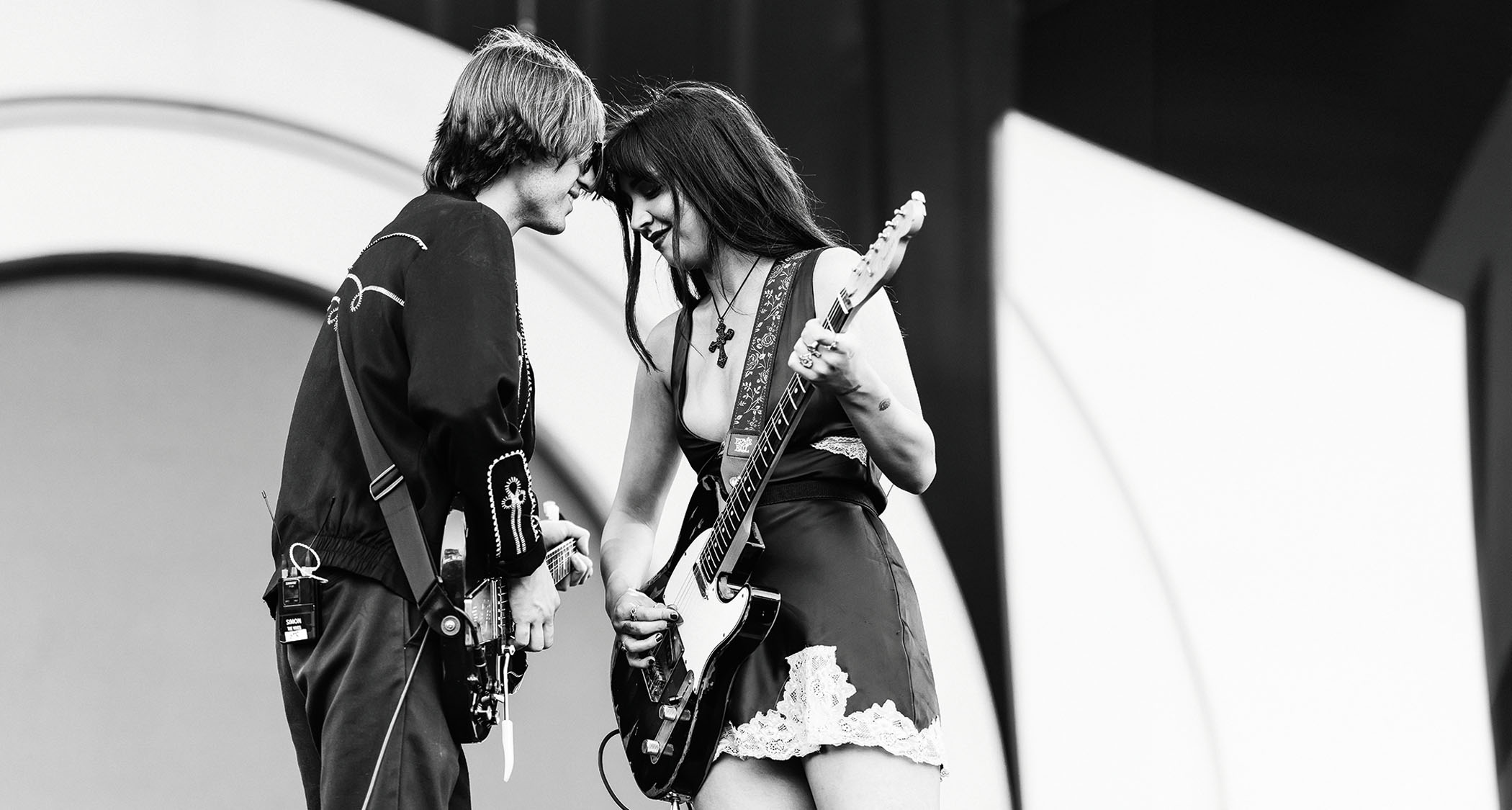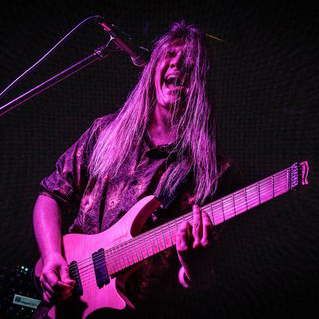“Atmosphere has always been more interesting to me than who can do the quickest solo – I’d rather make people feel uneasy or happy with the parts I play”: After supporting Arctic Monkeys in stadiums, The Mysterines rewired their tones – and abilities
Lia Metcalfe and Callum Thompson pull us into the alternative reality and creative logic behind the thrilling sound of The Mysterines. It's all about shock, awe and the process of unlearning

When it comes to the difficult second album, most bands look to consolidate everything they’ve learnt up to that point and go one better. But with Afraid Of Tomorrows, Liverpool-based alt-rock quartet The Mysterines did the opposite: they ripped the carpet from beneath them.
They were still teenagers when their “innocent and naive” debut album Reeling was released in 2022. They’ve since toured the States, played stadiums in support of Arctic Monkeys and, as guitarist Callum Thompson says, become different people…
“We’re at different stages of our lives,” he explains. “We wanted to steer the songs in unorthodox ways, and have parts that don’t feel like guitars. This album was more about evoking a certain feeling or atmosphere as opposed to just playing a blues lick. Atmosphere has always been more interesting to me than who can do the quickest solo; I’d rather make people feel uneasy or happy with the parts I play. The less busy my right hand is, the better.”
Guitarist/vocalist Lia Metcalfe admits the band “threw everything” at Reeling as they sought to show the world what they were made of. This time, there is no whiff of ego or flash of performative fireworks. Afraid Of Tomorrows was forged in the heat of the moment. They didn’t dilute ideas by overworking them.
Says Callum: “The more you do something, the worse it gets, especially when you’re trying to orchestrate a feeling with your guitar. The part that came to you initially will always sound better than something you’ve been chipping away at over a long period of time.” Lia agrees: “If you think about a part too much, it loses its conviction.”
Callum continues: “I’ve spent most of my life playing and learning about the guitar. I’m not saying I’m Guthrie Govan, but I do know what I’m doing. It’s become about unlearning everything I know and trying to do things wrong, but in a way that it sounds better than doing them right.
“If we all did everything out of the book, everyone would sound the same. I’m more interested in doing weird things that aren’t right but sound cool. I wanted to reclaim that naivety.”
All the latest guitar news, interviews, lessons, reviews, deals and more, direct to your inbox!
Lia guides her songs with a dark vocal performance, and doesn’t see herself as a guitarist, which is something Callum adores. “That’s the magic,” he says. “There’s a different feel when Lia plays. There are all these blemishes which aren’t perfect but make it great.”
The band spent a month tracking the new record in LA with Grammy-winning producer John Congleton (Phoebe Bridgers, Explosions in the Sky, St. Vincent). They knew there would be a war chest of guitars to experiment with there, and so they took just one guitar each.
Lia grabbed her road-beaten American-made Telecaster. It’s a guitar that can take a beating, and looking at its chipped paintwork, it’s taken plenty. For Callum, it was always going to be his 1963 reissue Gibson SG.
He was first drawn to the SG after seeing one played by Thom Yorke during a performance of the Radiohead song Bodysnatchers.
“It’s not as big, bulky or rich as a Les Paul,” he says. “It still has the Gibson sound but it’s not as powerful. I like to keep the guitar as on the edge as possible and then push it with pedals. If you put a fuzz on a Les Paul it eats up all the space, but an SG has a lot more clarity in the tone; it clips in the perfect places.”
During the recording process, they knew the familiarity they have with their instruments would go a long way. “It was important,” Callum says, “to take the guitars that have been all over the world with us. The ones that we’re comfortable with.”
A number of Congleton’s semi-hollow-bodied guitars were consequently plucked off the studio walls, including an Epiphone Casino and a feast of Gibson ES-335s. “John’s got amazing guitars,” Callum beams. “There were loads of nice paint brushes to use.”
There was also a guitar which the band can’t remember the details of, but it played an oddly charming role on the sleazy, snarling Junkyard Angel. “There was this blue guitar; all I remember is that it was Japanese and John said he’d never seen anything like it,” Lia recalls. “It sounded really tinny and the strings felt like they hadn’t been changed in years, but it was amazing.”
I had an idea for a solo for ages but I couldn’t get it out of my head. It was kind of a Jonny Greenwood stuttering thing and when I spoke to John he pulled out a TKOG Mini Glitch. It was exactly what I was after
In contrast to their appetite for exploring Congleton’s guitar collection, simplicity was the mantra when it came to amps. Lia predominantly used a Fender Reverb Deluxe, while Callum jumped between a Marshall Plexi similar to the one in his live rig, and “a 1950s 5- or-10 watt Fender tube that broke up really nicely.”
The emphasis was not so much on the gear involved, but the execution of the player. “With the guitar and amp side of things, we didn’t want to go too crazy,” Callum says. “It was more about attacking the parts in different ways.”
With the amp arsenal streamlined, the pair could spend more time experimenting with pedals. And lots of them. Callum would have “a million different pedals all over the floor” at any given time, with a few cutting above the rest.
There’s just something about the repeats when you use it as a slapback that you just can’t beat. I loved digging in with it
“I had an idea for a solo for ages but I couldn’t get it out of my head,” he says. “It was kind of a Jonny Greenwood stuttering thing and when I spoke to John he pulled out a TKOG Mini Glitch. It was exactly what I was after. They’re a bit of a lottery; you literally don’t know what you’re going to get every time you press it. I soon realised that putting it on only for little bits was a lot better than having it on all the time, to stop it going too mad.
“One pedal that changed everything was an ’80s Boss DD-2 digital delay,” he adds. “There’s just something about the repeats when you use it as a slapback that you just can’t beat. I loved digging in with it, and I liked it so much I’ve got a second one now, a DD-3, which I use for a stuttering delay.
“They changed the game for me. I’d only used delay pedals for floaty, reverby type things before, but with these two, I was changing my tone. And when you set it quick, it’s got a really pokey high-mid that makes it sound like a computer, which I like.”
As Lia remembers it: “John didn’t want to tell us how pedals worked. He left us to mess with them and figure out our own way.”
Experimentation extended beyond pedals, too. “We used a lot of EBow,” Lia says, “and Cal used a violin bow a lot to create a lot of interesting noises and atmospheres. It gave the songs a really nice dissonance. John really liked it when it wasn’t clear what key the song is in or where it’s going to go, so they were tools to achieve that.”
Every step of the way, the guitarists refused to settle for the obvious answer. “Everything that we knew would work, every instinct we had, we’d do the opposite to challenge ourselves,” Lia says. “We wanted to shock ourselves. If we’d normally play with loads of reverb, we’d take it off and have the signal as dry as possible, and that was a really fun part of making the record.”
Their time in Congleton’s studio has naturally left a mark on their live pedalboards, although there was an eagerness not to go too crazy.
“I’ve been using the Banana Mandala for the glitch effects live,” Callum says. “I’d have been there for weeks if I wanted exactly the same sound as I have on the record, but this does something similar.”
His amp-pushers come via two Electro-Harmonix pedals, the Soul Food and Russian Fuzz, with a third in the form of a Memory Man adding to the delay offerings of his DD-2 and DD-3 pedals. TC Electronic’s Hall of Fame is his reverb of choice.
That pedal also sits on Lia’s ’board, alongside a Fulltone OCD overdrive, a modern Boss DD-7 delay and a Boss tuner, with no new additions coming off the back of their experiences in the studio. Instead, they’re rediscovering what they already have, “using them in different way and seeing where that takes you,” as they continue to push against the tides of comfort and safety.
Afraid Of Tomorrows shows a maturing band, but one with a drastically overhauled sound. But they aren’t getting comfortable. “Why wouldn’t you want to keep evolving?” Lia asks. “I don’t think it’s within us to make the same record twice. We’re constantly being inspired by new things. We can’t stay in the same place.”
- Afraid Of Tomorrows is out now via Fiction Records.
A freelance writer with a penchant for music that gets weird, Phil is a regular contributor to Prog, Guitar World, and Total Guitar magazines and is especially keen on shining a light on unknown artists. Outside of the journalism realm, you can find him writing angular riffs in progressive metal band, Prognosis, in which he slings an 8-string Strandberg Boden Original, churning that low string through a variety of tunings. He's also a published author and is currently penning his debut novel which chucks fantasy, mythology and humanity into a great big melting pot.







